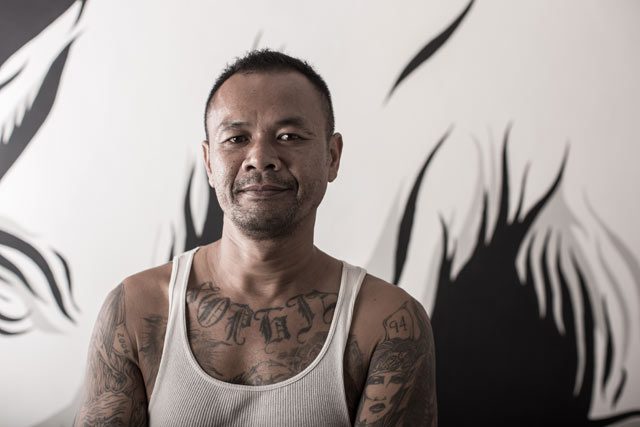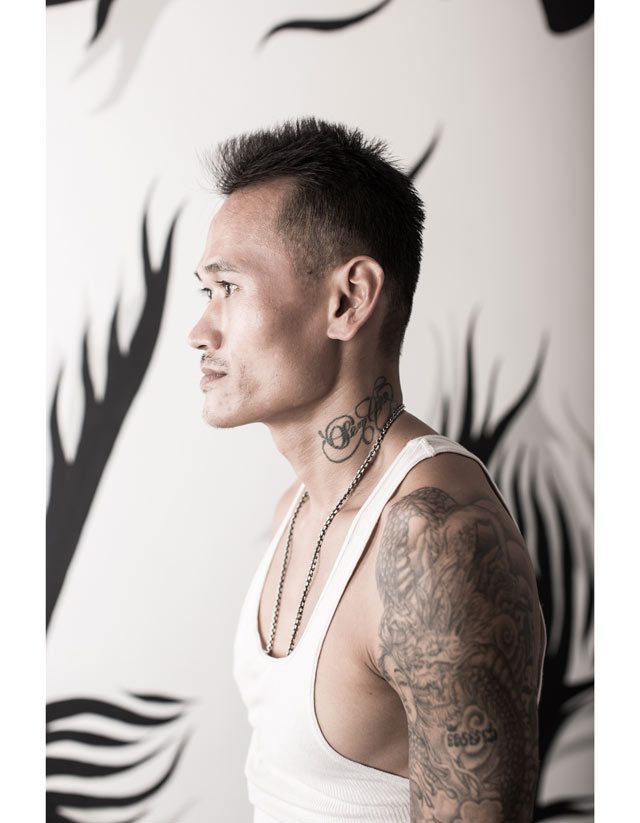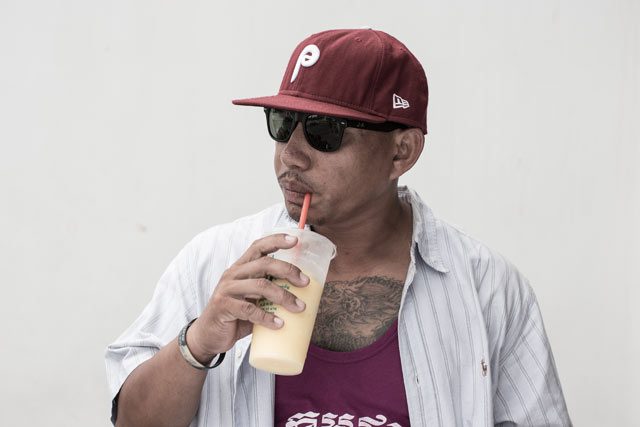They started to trickle in at 11am on a sunny morning in Phnom Penh. Curious and excited, old friends and acquaintances began catching up after several years. New arrivals were more timid and unsure of what to expect. This was an historic moment: the first time this group of deported Cambodian-Americans – self-referenced as “returnees”, “homies” and “Khmer-exiled Americans (KEAs)” – were getting together in a self-organised meeting (not one organised by an NGO or church group) to assess their current situations as a collective and decide what they could do with their combined skills and resources.
Each person and story is unique, but they share similar trajectories. Chalk C, 37, was born in a Khmer Rouge prison camp. “My mom was in shackles with six or seven other people when she gave birth,” he explained. “The other people that were locked up with her in the hut said [she should] just throw me away because there was no way I could survive with no food to eat. My dad went through some shit to keep me alive. He walked for a day-and-a-half until he saw a makeshift Red Cross clinic.”
The majority of returnees were born in Thai refugee camps and, in the early 1980s, were whisked away by American missionaries to various locations in the US, with the largest communities settling in Long Beach, California; Seattle, Washington; Lowell, Massachusetts; and Philadelphia, Pennsylvania.

Once there, many families experienced continued displacement and migration as they tried to resettle and carve out their own communities. “I was born in a Thai refugee camp and don’t remember anything about the move to the US because I was only one-and-a-half years old,” said So, a 30-year-old female returnee. “We arrived by plane in Seattle, then moved to San Antonio, Texas, where we lived until I was about four. We then moved to Fresno, California, before settling in Long Beach for almost 20 years.”
Displaced, socially excluded and the brunt of much racial discrimination, many youths resorted to gang involvement for protection and a feeling of inclusion. “I was the only Cambodian in my school,” remembered Tiger, 36, of his experiences in a midwestern Christian school. “Kids would make fun of me, saying: ‘Chinese, Chinese’. I felt awkward. A bunch of older Asian guys needed someone to use. I had to steal and give to the gang to support their habits. I was 13; they were 19. The older dudes made me feel accepted.”
Even those who avoided gang involvement would often engage in illegal activities. Eventually they all ended up in the US penal system.
In 1996, during the Clinton administration, Congress passed the Illegal Immigration Reform and Immigrant Responsibility Act, which stipulates that any non-citizen living in the US can be deported if convicted of an aggravated felony, with no chance for appeal. As permanent resident ‘aliens’, rather than citizens, many of the Cambodians were charged with additional immigration crimes while serving time for their original offences.
“I was so excited, itching to walk out of the door as a free man after serving nine-and-a-half years for my crimes,” said Peye, 37. “But then I was cuffed and sent to immigration prison for a year-and-a-half for a crime I didn’t even know I committed.”

Others were released from prison, served their parole and integrated back into the community. Some were out for a few months, or even years, before being “picked up” by Immigration and Customs Enforcement during routine check-ins. One returnee, who wished to remain nameless, had completed his prison sentence 13 years prior to being detained in detention centres and then deported. He left behind three children, a career in laser machine operation and a home, which was subsequently foreclosed.
After initially refusing to sign repatriation agreements with the US, the Cambodian government was strong-armed into it in 2002. The deportation flights started the same year, on private chartered jets, with returnees shackled at the ankles and wrists. “Being transported through immigration from one place to the next, it’s trafficking, plain and simple,” said Ko, a 33-year-old returnee. “Coming back [to Cambodia] was brutal, it took almost three days, shackled and waist-chained the whole way.”
There are currently about 400 returnees in Cambodia, including 11 females, with some reports estimating that approximately 2,000 Cambodian-Americans are on “the list” in the US, awaiting deportation to a foreign land.
Most returnees had never set foot in Cambodia before and, with no predecessors to prepare them for what laid ahead, the early arrivals had it tough. Communication technology and social mobility opportunities were limited. Some returnees clung to their gang mentalities, meaning the group as a whole became associated with violence and were stigmatised.
“I couldn’t speak Cambodian. They [Cambodians] could barely understand me. I spoke in street slang,” said Tiger.
“I was the quiet type, but we still used to get into lots of fights when we first got here.”
Returnees with visible tattoos struggle to integrate into society, while others turn to drugs for survival – as a coping mechanism and a way of making money. As a group, the returnees have gained a bad reputation, and this was part of the reason for the meeting. Attended by a total of 20 returnees throughout the day, the meeting was a chance for them to talk collectively about their issues and figure out ways to assist those already here and also those yet to arrive. Fighting the stigma and dispelling the stereotypes were also on the agenda.
“Local people don’t understand us. They see my tattoos, and that’s it; they don’t wanna talk to me,” said Domino. “They’re scared of me. I’m struggling to survive day-to-day.”

Among the ideas floated, most were in agreement that a drop-in centre would be a key development. “It could be a space where we could provide our own cultural orientation for new arrivals,” Domino said. “We could help with paperwork and getting people jobs. It could be a place to network and support each other.”
A very small organisation, the Returnee Integration Support Centre (Risc), provides some of these services, although it has had to scale back dramatically following major cuts in funding. While Risc still provides limited support to those most in need on a case-by-case basis – particularly those with mental or physical health issues – they are unable to offer the social and cultural network that the returnees identified as important.
“Some day, we want to be able to provide housing for those guys who need it the most, like those without family. We also want to give money to startup projects,” said Dicer, one of the earlier arrivals, now aged 45. “Some of us have been here a long time and working in harm reduction. We could provide our own drug counselling, too.”
Indeed, a quick brainstorm of the skills and experience they possess as a group throws up abilities from English language and hospitality to marketing and media, from acting and hip-hop to accounting and IT.
Trip Locc, a 34-year-old who has been in Cambodia for more than ten years, pointed out that he knew of fellow returnees with practical experience in “masonry, carpentry, construction, car mechanics and hairdressing”.
Some of these skills were transferred from the US, while others were developed once the returnees arrived in Cambodia. Current employment for some of the returnee community includes roles in media companies, harm reduction NGOs, mechanic shops, performance groups, advertising agencies and English schools.
Understanding the importance of sustainability as a collective, the returnees have floated the idea of setting up their own English school, performance school or training centre, which could help sustain them as a small business or social enterprise.
“I am happy with my life and where it is going now,” said So, a female returnee currently employed as a sales executive for an events company. “I have accomplished so much more in Cambodia than I did in the States, but the sad part of my story is that I am separated from my son and my family. They are my biggest supporters, and I wish I could be reunited with all of them. My family just wants to see me happy and doing something with my life. Half a world away, they are proud of me.”
This article was written in collaboration with The Other Cambodians, a collective formed by returnees.


